Author: Scott KLEINE, Bryan K. LEES & Malcolm SOUTHWOOD Date: 2014-9-6 17:54:59

Orpiment collecting operation using heavy equipment. Collector’s Edge photo.
The Twin Creeks mine lies at the intersectionof the renowned Getchelltrend and the lesser-known Valmy trend,along which lie a number of other Carlin-type gold deposits. At Twin Creeks theorpiment bodies occur in rocks of theComus Formation, a thick sequence ofcarbonates, siltstones, basaltic rocksand tuffs of Ordovician age which containmost of the sulfide gold reserves at Twin Creeks which are mined in theMega pit.
Collecting operation using heavy equipment, note yellow opriment rich zones in the upper photo. Collector’s Edge photo.
The Robert’s Mountain Thrustbrings another Ordovician formation –the Valmey Formation – over the ComusFormation. The Valmey Formation is unconformablyoverlain by the Etchart Formation(limestones, siltstones andsandstones of Permian age) which hostthe mine’s oxide gold reserves, but no orpiment.
Collecting orpiment specimens in the pocket-rich zone. Collector’s Edge photo.
Oxide gold ores are mined in theVista pit. Unmineralized mudstones, siltstones,and sandstones of Mississippian-Permian age – the Havallah Formation – have in turn been thrust over the EtchartFormation, and the entire Palaeozoicsequence has been cut by sills and dikesof Cretaceous granodiorite which, again,is not mineralized. “Tertiary” volcanicsand “Tertiary”/Quaternary alluviumoverlie the Palaeozoic rocks.
The gold (and orpiment) mineralizationis much younger than the hostrocks and is structurally controlled,occurring in a complex north-trending fold called the Conelea anticline, whichdeveloped during the Antler Orogeny.
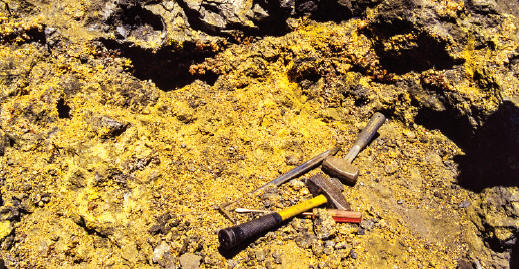
Collecting orpiment specimens in the pocket-rich zone. Collector’s Edge photo.
The mineralization post-dates the anticlineand occurs within the overturnednose of the fold, which has in turn beenbroken up by a series of north-easttrending faults. The best-crystallised orpimentis found in the upper hinge areaof this fold structure, where maximumstress resulted in open areas that providedconduits for mineralizing fluidsand cavities conducive to crystal formation.
These areas also contain some ofthe highest gold grades in the deposit.
The mineralization event has been datedby argon isotope analysis at 41.9 Ma.
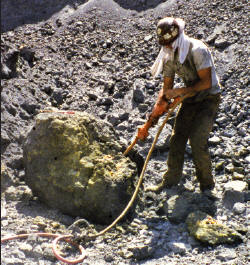
Working on an orpiment rich boulder using a drill hammer. CE photo.
Low grade orpiment is abundantthroughout the northern portion of theTwin Creeks Mega pit, and mapping theorpiment mineralization has been usefulfor mine geologists because of the strongcorrelation with high gold grades. Wellformedcrystals were discovered in theopen spaces in the nose of the anticline,in rocks that are heavily decalcified,argillized and silicified. The decalcificationand silicification processes enlargedand strengthened the cavities initiatedby folding and provided ideal conditionsfor orpiment crystallization. In somecases fluids, possibly of meteoric origin,have remobilized and deposited a fine,light-coloured coating on the surfaces ofsome of the orpiment crystals. Analysishas shown that this coating typicallycomprises around 40% silica, and that itis rich in aluminium (c.7%) and iron(c.4%).
ORPIMENT DISCOVERIES AND PROJECT DEVELOPMENT
Specimen quality orpiment was firstencountered by mine geologists in late 1998, on the 4220 bench of Cut 62, whichcoincided with the deepening of thenorthern portion of the pit over the Coneleaanticline. The quality of the crystalswas better than anything that had beenencountered previously, and this encouragedmine geologist Leroy Schutz to contactCollector’s Edge. It was agreed thatthe mine geologists would continue tomonitor the orpiment rich zones forsigns of better specimens. Early in 1999,mining in Cut 62 continued downthrough increasingly better orpimentzones, until in March incredible orangecolored orpiment was discovered byNewmont geologist Pat Donovan.
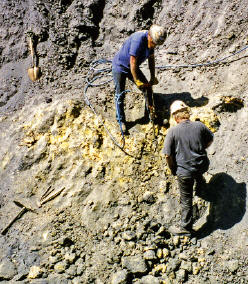
Working in orpiment rich zone using a drill hammer. Collector’s Edge photo.
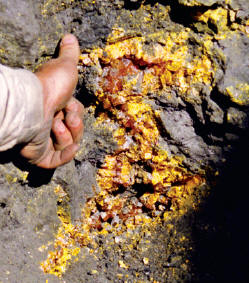
Pocket with orpiment crystals in situ. Collector's Edge photo.
At this point Newmont’s regionalgeologist, Ron Thoreson, contactedCollector’s Edge to propose an on-siteevaluation. Ken Roberts, working forCollector’s Edge at the time, travelled to the mine, intending to spend a day inspectingthe find, but ended up stayingan entire week collecting the newly discoveredpocket on the 4220 bench of Cut62. Sadly, many of the specimens wereblast-damaged and few really fine pieceswere discovered. Nevertheless, the potentialwas clear; this orpiment discoverywas world-class.




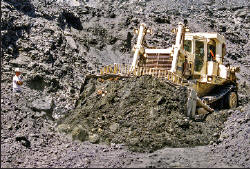
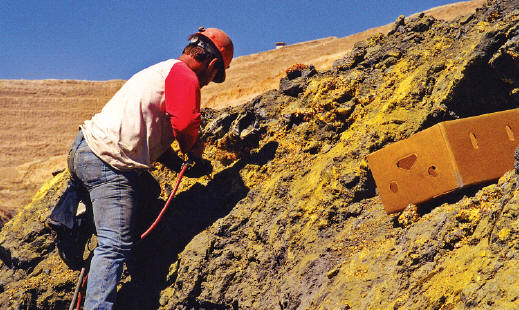




 YueGongAnBei 44051102000467
YueGongAnBei 44051102000467


 |
|